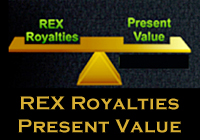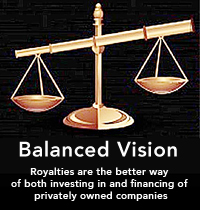
 1. The Basic Model: rex-basic.com
1. The Basic Model: rex-basic.comThis calculator allows users to enter their own data to view and understand the impact of royalty rates and other variables on a royalty transaction. The user enters the revenue projections believed to be realistic. This is the basic starting point in understanding how royalties can be used.
2. Comparing Two Models: rexcomparator.com

Users of this website are able to compare different royalty rates, royalty structures, maturities and amount to be paid for the royalty, all using the same projected revenues. It is most useful when deciding which of two royalty transactions would yield the best results for investors and business owners.

Users of this website are able to compare different royalty rates, royalty structures, maturities and amount to be paid for the royalty, all using the same projected revenues. It is most useful when deciding which of two royalty transactions would yield the best results for investors and business owners.
 3. Combination of Debt and Royalties: rexdebt-shareroyalties.com
3. Combination of Debt and Royalties: rexdebt-shareroyalties.comThis approach is frequently best for both investors and business owners of early stage companies with no revenues, or unproven revenues. A modest royalty commences upon the repayment of a loan, which bears interest below market rates, for an agreed number of years. The investor receives reasonable interest, and has no capital risk after the loan is repaid; the majority of his long-term return on investment comes from the royalty.
 4. Present Value Model: rex-pv.com
4. Present Value Model: rex-pv.comThis model calculates the Internal Rate of Return (IRR) received each year by the holder of a royalty, and the amount a potential buyer of the royalty would need to pay the original investor to achieve a target IRR. It also calculates the royalties to be received by the new investor, the annual IRR and therefore the period necessary for the new investor to be capital risk free based on the price paid, assuming projected revenues are achieved.
 5. Performance-based Scaled Royalties: rexscaledroyalties.com
5. Performance-based Scaled Royalties: rexscaledroyalties.comUseful for negotiation of a transaction. If a company exceeds its revenue projections, it is rewarded; if it misses its revenue projections, investors are compensated. Users define the number of years in a Selected Adjustment Period (SAP) and the percentage variance from Projected Revenues which trigger a Plus or Minus condition. They may negotiate the resulting change in royalty rates and other elements of the transaction, were the trigger points to be reached.
6. Royalty Issuer Assured Return: rex-riar.com

This powerful online model allows both investors and companies considering issuing a revenue royalty to begin with the level of investment return required, and then determine how to assure that return with a pattern of royalties payments over time. The cost of the assurance of financial performance by the company affects the rate of return, and this can be easily and quickly analyzed with the RIAR model. An additional convenience is that data entered into this model is automatically also available with the original, straightforward model at rexroyalties.com.

This powerful online model allows both investors and companies considering issuing a revenue royalty to begin with the level of investment return required, and then determine how to assure that return with a pattern of royalties payments over time. The cost of the assurance of financial performance by the company affects the rate of return, and this can be easily and quickly analyzed with the RIAR model. An additional convenience is that data entered into this model is automatically also available with the original, straightforward model at rexroyalties.com.
